A Review on Advanced Battery Thermal Management Systems for Fast Charging in Electric Vehicles
Abstract
1. Introduction
2. Battery Thermal Issues during Fast Charging
2.1. Generated Heat Loss in Li-Ion Battery
2.2. Thermal Characteristics of Li-Ion Battery
3. Advanced Cooling Strategies for Thermal Management of Batteries in Fast Charging
3.1. Indirect Liquid Cooling
3.2. Direct Liquid Cooling
3.3. Hybrid Cooling
4. Summary and Recommendations
- (a)
- Indirect cooling systems impose several concerns in the advanced battery thermal management technique such as their complex design, liquid leakage, corrosion risk, high energy consumption, increased system weight, and high maintenance cost. In addition, the large thermal resistance between the cooling structures in the indirect cooling system and the battery surface also significantly reduces the heat transfer coefficient and cooling performance. Therefore, the application of indirect cooling systems in the field of fast charging for high-capacity battery packs in the future needs to be carefully studied and evaluated.
- (b)
- Direct liquid cooling or immersion cooling is gaining much attention as an advanced battery thermal management method. This cooling method works by allowing liquid to directly contact the battery cell surface, thereby reducing thermal resistance and significantly increasing the heat transfer coefficient, which improves heat dissipation efficiency and provides superior cooling performance. In addition, direct liquid cooling with a two-phase cooling mechanism using low-boiling point fluids has provided superior heat dissipation efficiency compared to single-phase cooling and indirect liquid cooling. Therefore, direct liquid cooling is considered a potential candidate for advanced battery thermal management. However, to guarantee the practical applicability of direct liquid cooling for battery thermal management on a larger scale, in-depth research studies need to be executed reflecting the relation between influential and performance parameters. Thus, databases generated based on these research studies will act as guidelines to design and develop the next-generation battery immersion cooling system.
- (c)
- With the great advantage of high latent heat when the solid–liquid phase change occurs, PCM cooling has brought about superior heat dissipation performance and provided temperature uniformity by absorbing large amounts of heat released from battery packs during fast charging. In addition, PCM cooling is a passive cooling method. The application of this cooling method allows for reduced energy consumption in the system and is more compact in space requirements. However, the low thermal conductivity of PCM is a challenge that makes it difficult to meet the heat dissipation requirements of battery packs during fast charging. Therefore, the concept of hybrid cooling is considered an advanced battery thermal management strategy by combining the advantages of liquid cooling and PCM cooling.
- (d)
- The selection of a suitable advanced cooling strategy should also be evaluated based on larger-scale production and harsh environmental operations. In the case of direct liquid cooling, the leakage of coolant is the primary concern, which could deplete the battery thermal management performance. Also, the coolant weight could make the cooling system bulky and affect the range enabled by the battery system. In addition, the highly viscous and denser coolant can cause an increase in pumping power. Therefore, while considering the commercial-scale production of a battery with an advanced cooling strategy, the overall cost of the cooling system based on the aforementioned indicators needs to be examined. In harsh environments with high temperatures, high humidity, and high corrosion, cooling systems can wear out more quickly. Therefore, the choice of materials, insulation, and sealing techniques inevitably becomes important and costly.
- (e)
- To effectively implement advanced battery thermal management strategies for fast charging in electric vehicles, a few recommendations have been made for stakeholders, including manufacturers, policymakers, and researchers: The immersion cooling technique could be optimized at the commercial scale considering environmental friendly coolants with enhanced heat transfer performance, coolant flow distribution based on inlet/outlet configurations, cell arrangements, and spacing, as well as relevant influential operating parameters such as flow rate, temperature, and ambient condition. Thermal runaway models should be developed, and real driving tests should be conducted to ensure the safe operation of the battery system with an advanced cooling strategy under extreme operating conditions. Governments and organizations can introduce financial incentives, such as tax breaks or subsidies, to encourage the adoption of advanced cooling technologies that are highly efficient in cooling and energy saving.
Author Contributions
Funding
Data Availability Statement
Conflicts of Interest
References
- Emissions by Sector. Available online: https://ourworldindata.org/emissions-by-sector (accessed on 17 November 2022).
- Polat, H.; Hosseinabadi, F.; Hasan, M.M.; Chakraborty, S.; Geury, T.; El Baghdadi, M.; Wilkins, S.; Hegazy, O. A Review of DC Fast Chargers with BESS for Electric Vehicles: Topology, Battery, Reliability Oriented Control and Cooling Perspectives. Batteries 2023, 9, 121. [Google Scholar] [CrossRef]
- Garud, K.S.; Tai, L.D.; Hwang, S.; Nguyen, N.; Lee, M. A Review of Advanced Cooling Strategies for Battery Thermal Management Systems in Electric Vehicles. Symmetry 2023, 15, 1322. [Google Scholar] [CrossRef]
- Ye, Y.; Mao, Y.; Zhao, L.; Chen, Y.; Chen, M. Experimental investigation of thermal runaway behavior and propagation inhibition of lithium-ion battery by immersion cooling. Appl. Therm. Eng. 2024, 256, 124093. [Google Scholar] [CrossRef]
- Wu, X.; Lu, Y.; Ouyang, H.; Ren, X.; Yang, J.; Guo, H.; Han, X.; Zhang, C.; Wu, Y. Theoretical and experimental investigations on liquid immersion cooling battery packs for electric vehicles based on analysis of battery heat generation characteristics. Energy Convers. Manag. 2024, 310, 118478. [Google Scholar] [CrossRef]
- Huang, H.; Li, W.; Xiong, S.; Luo, Z.; Ahmed, M. Single-phase static immersion-cooled battery thermal management system with finned heat pipes. Appl. Therm. Eng. 2024, 254, 123931. [Google Scholar] [CrossRef]
- Suresh Patil, M.; Seo, J.; Lee, M. A novel dielectric fluid immersion cooling technology for Li-ion battery thermal management. Energy Convers. Manag. 2021, 229, 113715. [Google Scholar] [CrossRef]
- Han, J.-W.; Hwang, S.-G.; Garud, K.S.; Lee, M.-S.; Lee, M.-Y. Numerical Study on Oil Cooling Performance of The Cylindrical Lithium-Ion Battery Pack with Flow Arrangement. J. Korea Acad. Ind. Coop. Soc. 2022, 23, 19–25. [Google Scholar] [CrossRef]
- Fan, Y.; Wang, Z.; Xiong, X.; Zhu, J.; Gao, Q.; Wang, H.; Wu, H. Novel concept design of low energy hybrid battery thermal management system using PCM and multistage Tesla valve liquid cooling. Appl. Therm. Eng. 2023, 220, 119680. [Google Scholar] [CrossRef]
- Wang, Y.; Gao, T.; Zhou, L.; Gong, J.; Li, J. A parametric study of a hybrid battery thermal management system that couples PCM with wavy microchannel cold plate. Appl. Therm. Eng. 2023, 219, 119625. [Google Scholar] [CrossRef]
- Keyser, M.; Pesaran, A.; Li, Q.; Santhanagopalan, S.; Smith, K.; Wood, E.; Ahmed, S.; Bloom, I.; Dufek, E.; Shirk, M.; et al. Enabling fast charging—Battery thermal considerations. J. Power Sources 2017, 367, 228–236. [Google Scholar] [CrossRef]
- Tomaszewska, A.; Chu, Z.; Feng, X.; O’Kane, S.; Liu, X.; Chen, J.; Ji, C.; Endler, E.; Li, R.; Liu, L.; et al. Lithium-ion battery fast charging: A review. Etransportation 2019, 1, 100011. [Google Scholar] [CrossRef]
- Yang, S.; Zhang, Z.; Cao, R.; Wang, M.; Cheng, H.; Zhang, L.; Jiang, Y.; Li, Y.; Chen, B.; Ling, H.; et al. Implementation for a cloud battery management system based on the CHAIN framework. Energy AI 2021, 5, 100088. [Google Scholar] [CrossRef]
- Yang, S.; He, R.; Zhang, Z.; Cao, Y.; Gao, X.; Liu, X. CHAIN: Cyber Hierarchy and Interactional Network Enabling Digital Solution for Battery Full-Lifespan Management. Matter 2020, 3, 27–41. [Google Scholar] [CrossRef]
- Zhao, C.; Cao, W.; Dong, T.; Jiang, F. Thermal behavior study of discharging/charging cylindrical lithium-ion battery module cooled by channeled liquid flow. Int. J. Heat Mass Transf. 2018, 120, 751–762. [Google Scholar] [CrossRef]
- Larrañaga-Ezeiza, M.; Vertiz, G.; Arroiabe, P.; Martinez-Agirre, M.; Berasategi, J. A novel direct liquid cooling strategy for electric vehicles focused on pouch type battery cells. Appl. Therm. Eng. 2022, 216, 118869. [Google Scholar] [CrossRef]
- Giammichele, L.; D’Alessandro, V.; Falone, M.; Ricci, R. Experimental study of a direct immersion liquid cooling of a Li-ion battery for electric vehicles applications. Int. J. Heat Technol. 2022, 40, 1–8. [Google Scholar] [CrossRef]
- Deng, Y.; Feng, C.; E, J.; Zhu, H.; Chen, J.; Wen, M.; Yin, H. Effects of different coolants and cooling strategies on the cooling performance of the power lithium ion battery system: A review. Appl. Therm. Eng. 2018, 142, 10–29. [Google Scholar] [CrossRef]
- Kumar Thakur, A.; Sathyamurthy, R.; Velraj, R.; Saidur, R.; Pandey, A.; Ma, Z.; Singh, P.; Hazra, S.K.; Wafa Sharshir, S.; Prabakaran, R.; et al. A state-of-the art review on advancing battery thermal management systems for fast-charging. Appl. Therm. Eng. 2023, 226, 120303. [Google Scholar] [CrossRef]
- Khan, S.A.; Hussain, I.; Thakur, A.K.; Yu, S.; Lau, K.T.; He, S.; Dong, K.; Chen, J.; Xiangrong, L.; Ahmad, M.; et al. Advancements in battery thermal management system for fast charging/discharging applications. Energy Storage Mater. 2024, 65, 103144. [Google Scholar] [CrossRef]
- Gandoman, F.H.; Jaguemont, J.; Goutam, S.; Gopalakrishnan, R.; Firouz, Y.; Kalogiannis, T.; Omar, N.; Van Mierlo, J. Concept of reliability and safety assessment of lithium-ion batteries in electric vehicles: Basics, progress, and challenges. Appl. Energy 2019, 251, 113343. [Google Scholar] [CrossRef]
- Wu, W.; Wang, S.; Wu, W.; Chen, K.; Hong, S.; Lai, Y. A critical review of battery thermal performance and liquid based battery thermal management. Energy Convers. Manag. 2019, 182, 262–281. [Google Scholar] [CrossRef]
- Ye, Y.; Saw, L.H.; Shi, Y.; Tay, A.A. Numerical analyses on optimizing a heat pipe thermal management system for lithium-ion batteries during fast charging. Appl. Therm. Eng. 2015, 86, 281–291. [Google Scholar] [CrossRef]
- Bernardi, D.; Pawlikowski, E.; Newman, J. A general energy balance for battery systems. J. Electrochem. Soc. 1985, 132, 5. [Google Scholar] [CrossRef]
- Weng, J.; Yang, X.; Ouyang, D.; Chen, M.; Zhang, G.; Wang, J. Comparative study on the transversal/lengthwise thermal failure propagation and heating position effect of lithium-ion batteries. Appl. Energy 2019, 255, 113761. [Google Scholar] [CrossRef]
- Ning, G.; Haran, B.; Popov, B.N. Capacity fade study of lithium-ion batteries cycled at high discharge rates. J. Power Sources 2003, 117, 160–169. [Google Scholar] [CrossRef]
- Belt, J.R.; Ho, C.D.; Motloch, C.G.; Miller, T.J.; Duong, T.Q. A capacity and power fade study of Li-ion cells during life cycle testing. J. Power Sources 2003, 123, 241–246. [Google Scholar] [CrossRef]
- Shahid, S.; Agelin-Chaab, M. A review of thermal runaway prevention and mitigation strategies for lithium-ion batteries. Energy Convers. Manag. 2022, 16, 100310. [Google Scholar] [CrossRef]
- Doughty, D.H.; Roth, E.P. A general discussion of Li ion battery safety. Electrochem. Soc. Interface 2012, 21, 37. [Google Scholar]
- Chen, S.; Zhang, G.; Zhu, J.; Feng, X.; Wei, X.; Ouyang, M.; Dai, H. Multi-objective optimization design and experimental investigation for a parallel liquid cooling-based Lithium-ion battery module under fast charging. Appl. Therm. Eng. 2022, 211, 118503. [Google Scholar] [CrossRef]
- Chen, S.; Bao, N.; Garg, A.; Peng, X.; Gao, L. A Fast Charging–Cooling Coupled Scheduling Method for a Liquid Cooling-Based Thermal Management System for Lithium-Ion Batteries. Engineering 2021, 7, 1165–1176. [Google Scholar] [CrossRef]
- Lempert, J.; Kollmeyer, P.J.; He, M.; Haußmann, M.; Cotton, J.S.; Emadi, A. Cell selection and thermal management system design for a 5C-rate ultrafast charging battery module. J. Power Sources 2022, 550, 232121. [Google Scholar] [CrossRef]
- Wen, K.; Fu, X.; Pei, F. Research on the thermal management safety of the fast charging power battery management system. Energy Rep. 2023, 10, 3289–3296. [Google Scholar] [CrossRef]
- Qin, Y.; Xu, Z.; Du, J.; Guo, H.; Lu, L.; Ouyang, M. External Liquid Cooling Method for Lithium-Ion Battery Modules Under Ultra-Fast Charging. IEEE Trans. Ind. Appl. 2022, 58, 7658–7667. [Google Scholar] [CrossRef]
- Sun, J.; Chen, S.; Shen, K.; Zheng, Y. Liquid cooling system optimization for a cell-to-pack battery module under fast charging. Int. J. Energy Res. 2022, 46, 12241–12253. [Google Scholar] [CrossRef]
- Zhao, Z.; Kollmeyer, P.J.; Lempert, J.M.; Emadi, A. Experimental Comparison of Two Liquid Cooling Methods for Ultrafast Charging Lithium-Ion Battery Modules. In Proceedings of the IEEE Transportation Electrification Conference & Expo (ITEC), Chicago, IL, USA, 21–25 June 2021; pp. 46–51. [Google Scholar]
- Sarchami, A.; Kiani, M.; Najafi, M.; Houshfar, E. Experimental investigation of the innovated indirect-cooling system for Li-ion battery packs under fast charging and discharging. J. Energy Storage 2023, 61, 106730. [Google Scholar] [CrossRef]
- Han, U.; Lee, S.; Jun, Y.J.; Lee, H. Experimental investigation on thermal performance of battery thermal management system with heat pipe assisted hybrid fin structure under fast charging conditions. Appl. Therm. Eng. 2023, 230, 120840. [Google Scholar] [CrossRef]
- Adeniran, A.; Park, S. Optimized cooling and thermal analysis of lithium-ion pouch cell under fast charging cycles for electric vehicles. J. Energy Storage 2023, 68, 107580. [Google Scholar] [CrossRef]
- Li, M.; Ma, S.; Jin, H.; Wang, R.; Jiang, Y. Performance analysis of liquid cooling battery thermal management system in different cooling cases. J. Energy Storage 2023, 72, 108651. [Google Scholar] [CrossRef]
- Amalesh, T.; Lakshmi Narasimhan, N. Liquid cooling vs hybrid cooling for fast charging lithium-ion batteries: A comparative numerical study. Appl. Therm. Eng. 2022, 208, 118226. [Google Scholar] [CrossRef]
- Tan, X.; Lyu, P.; Fan, Y.; Rao, J.; Ouyang, K. Numerical investigation of the direct liquid cooling of a fast-charging lithium-ion battery pack in hydrofluoroether. Appl. Therm. Eng. 2021, 196, 117279. [Google Scholar] [CrossRef]
- Choi, H.; Lee, H.; Kim, J.; Lee, H. Hybrid single-phase immersion cooling structure for battery thermal management under fast-charging conditions. Energy Convers. Manag. 2023, 287, 117053. [Google Scholar] [CrossRef]
- Li, Y.; Bai, M.; Zhou, Z.; Wu, W.; Lv, J.; Gao, L.; Huang, H.; Li, Y.; Li, Y.; Song, Y. Experimental investigations of liquid immersion cooling for 18650 lithium-ion battery pack under fast charging conditions. Appl. Therm. Eng. 2023, 227, 120287. [Google Scholar] [CrossRef]
- Li, Y.; Bai, M.; Zhou, Z.; Wu, W.; Hu, C.; Gao, L.; Liu, X.; Li, Y.; Song, Y. Thermal management for the 18650 lithium-ion battery pack by immersion cooling with fluorinated liquid. J. Energy Storage 2023, 73, 109166. [Google Scholar] [CrossRef]
- Li, Y.; Bai, M.; Zhou, Z.; Wu, W.; Lv, J.; Gao, L.; Huang, H.; Li, Y.; Song, Y. Experimental studies of reciprocating liquid immersion cooling for 18650 lithium-ion battery under fast charging conditions. J. Energy Storage 2023, 64, 107177. [Google Scholar] [CrossRef]
- Yao, J.; Zhang, T.; Han, Z.; Chen, H.; Chen, H.; Liu, Z.; Huang, H. Study on the effect of immersion thermal management for high-current rate fast charging of 21700 Li-ion batteries. J. Energy Storage 2024, 85, 111061. [Google Scholar] [CrossRef]
- Hong, S.H.; Jang, D.S.; Park, S.; Yun, S.; Kim, Y. Thermal performance of direct two-phase refrigerant cooling for lithium-ion batteries in electric vehicles. Appl. Therm. Eng. 2020, 173, 115213. [Google Scholar] [CrossRef]
- Williams, N.; Trimble, D.; O’Shaughnessy, S. An experimental investigation of liquid immersion cooling of a four cell lithium-ion battery module. J. Energy Storage 2024, 86, 111289. [Google Scholar] [CrossRef]
- Lee, S.; Han, U.; Lee, H. Development of a hybrid battery thermal management system coupled with phase change material under fast charging conditions. Energy Convers. Manag. 2022, 268, 116015. [Google Scholar] [CrossRef]
- Behi, H.; Karimi, D.; Kalogiannis, T.; He, J.; Patil, M.S.; Muller, J.; Haider, A.; Van Mierlo, J.; Berecibar, M. Advanced hybrid thermal management system for LTO battery module under fast charging. Case Stud. Therm. Eng. 2022, 33, 101938. [Google Scholar] [CrossRef]
- Zheng, Y.; Shi, Y.; Huang, Y. Optimisation with adiabatic interlayers for liquid-dominated cooling system on fast charging battery packs. Appl. Therm. Eng. 2019, 147, 636–646. [Google Scholar] [CrossRef]
- Patil, M.S.; Behi, H.; Kalogiannis, T.; Steinhoff, B.; Stelter, E.; Sonnenberger, R.; Bramberger, R.; Casella, M.; Van Mierlo, J.; Berecibar, M. Advanced Hybrid Battery Thermal Management System for Fast Charging of Electric Vehicles. Transp. Res. Procedia 2022, 72, 2109–2116. [Google Scholar] [CrossRef]
- Chen, S.; Garg, A.; Gao, L.; Wei, X. An experimental investigation for a hybrid phase change material-liquid cooling strategy to achieve high-temperature uniformity of Li-ion battery module under fast charging. Int. J. Energy Res. 2021, 45, 6198–6212. [Google Scholar] [CrossRef]
- Choi, H.; Hong, J.; Lee, S.; Kim, D.; Lee, H. A novel battery thermal management system for cooling/preheating utilizing a polymer intercell heat exchanger with phase change material. Appl. Therm. Eng. 2024, 238, 122248. [Google Scholar] [CrossRef]
- Liu, X.; Wang, Q.; Luo, K.; Mu, Y.; Wang, H.; Fan, J. Numerical study on the effect of gallium filling on the cooling performance of battery thermal management system. Appl. Therm. Eng. 2024, 236, 121652. [Google Scholar] [CrossRef]
- Liu, Z.; Wang, B.; Chen, S.; Li, P. Lithium-ion battery pack thermal management under high ambient temperature and cyclic charging-discharging strategy design. J. Energy Storage 2024, 80, 110391. [Google Scholar] [CrossRef]
- Lv, Y.; Zhou, D.; Yang, X.; Liu, X.; Li, X.; Zhang, G. Experimental investigation on a novel liquid-cooling strategy by coupling with graphene-modified silica gel for the thermal management of cylindrical battery. Appl. Therm. Eng. 2019, 159, 113885. [Google Scholar] [CrossRef]
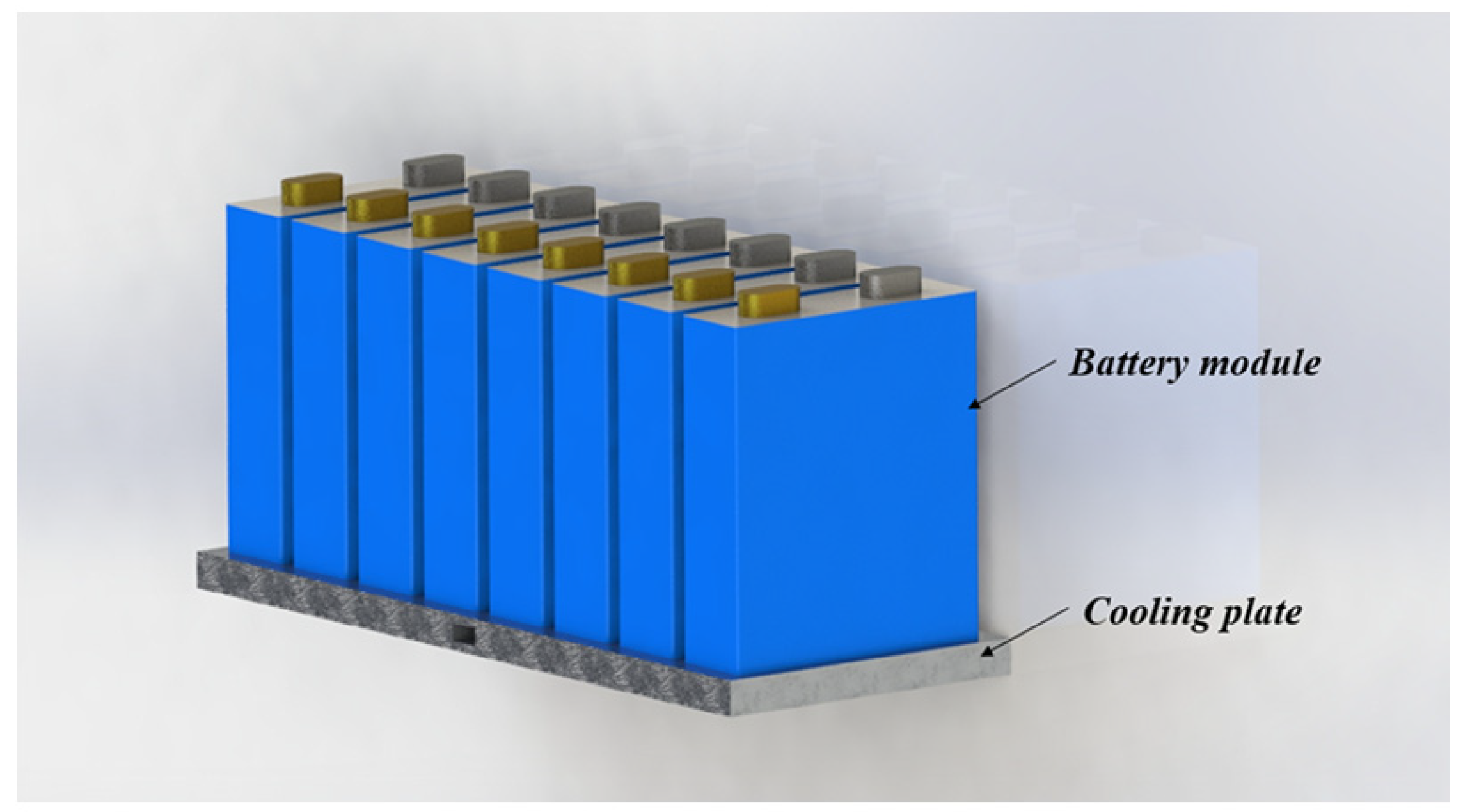

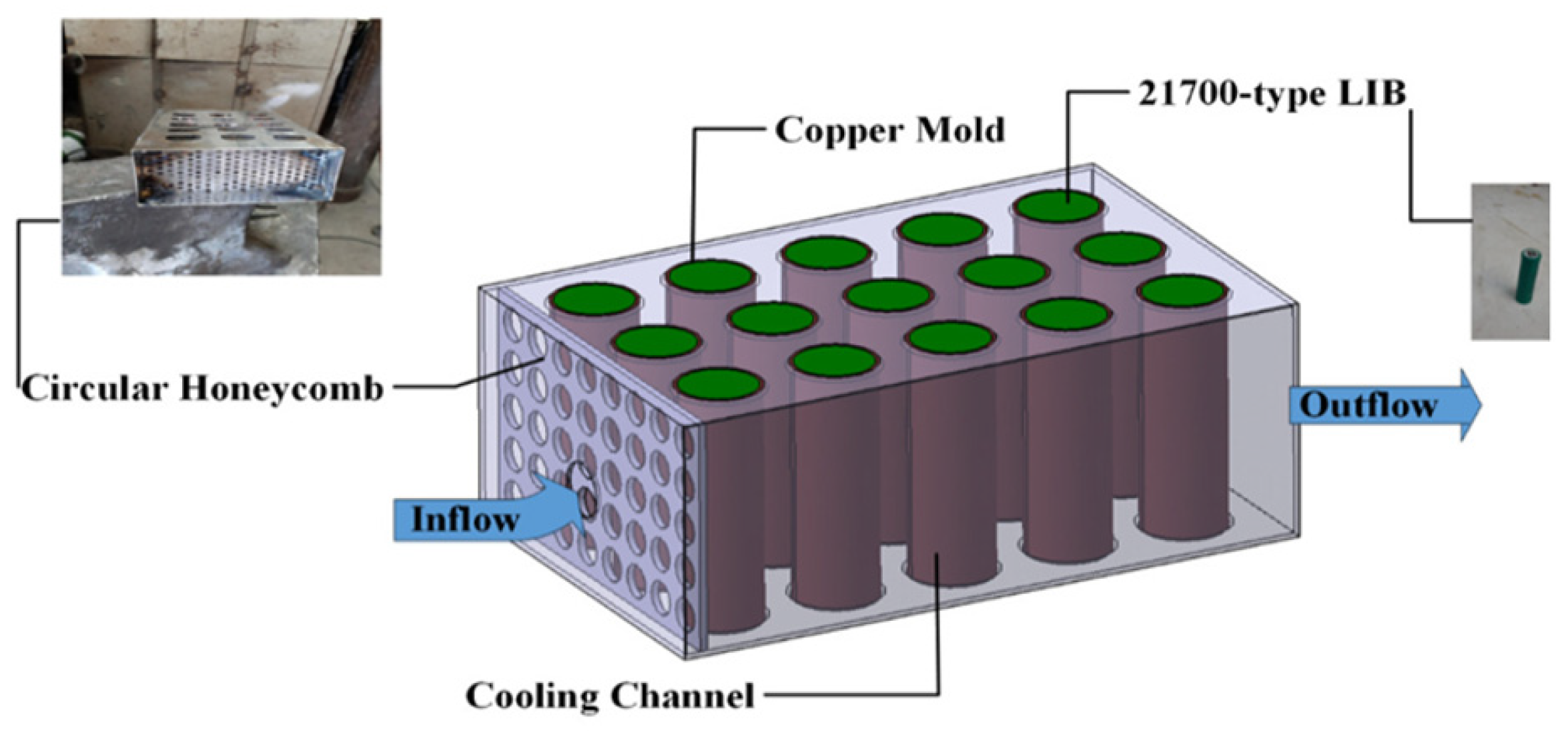
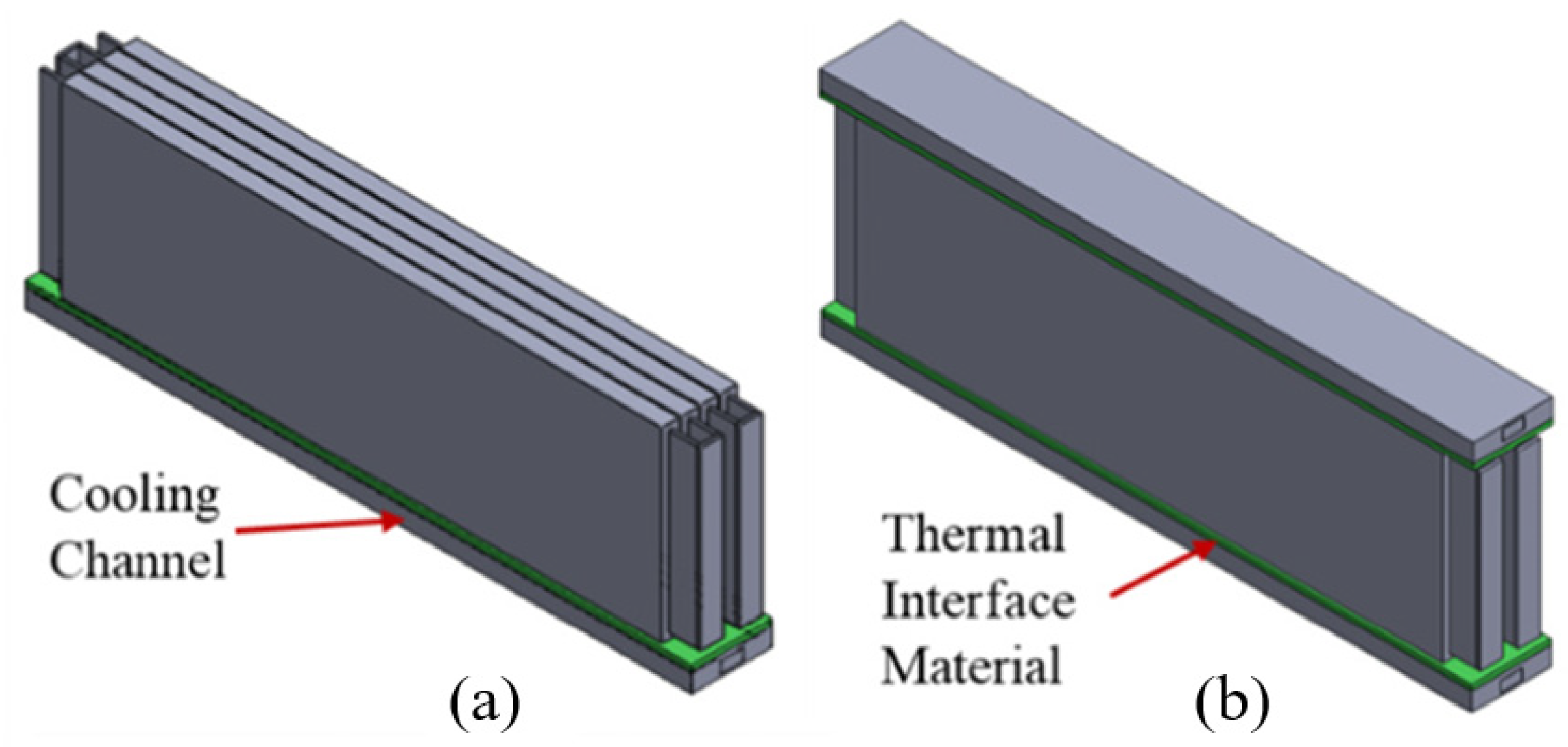
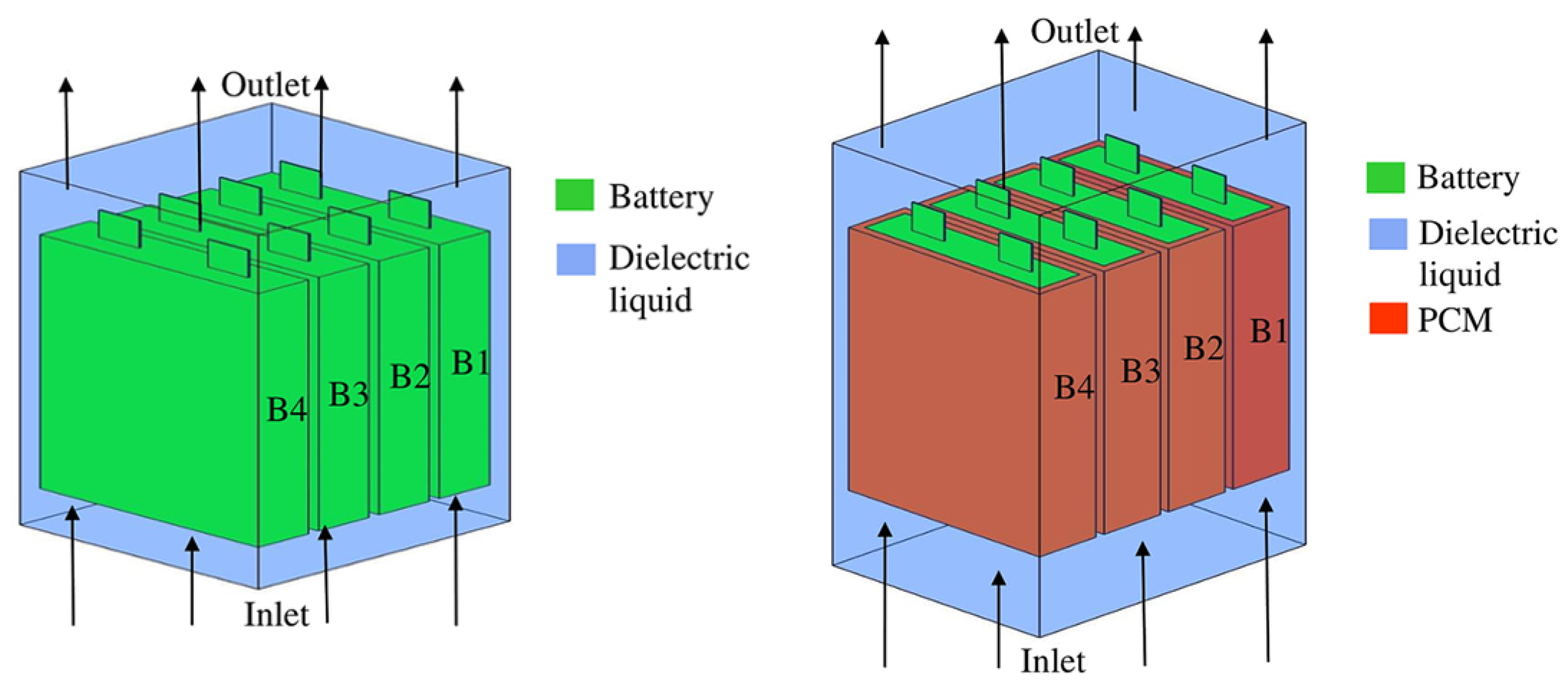

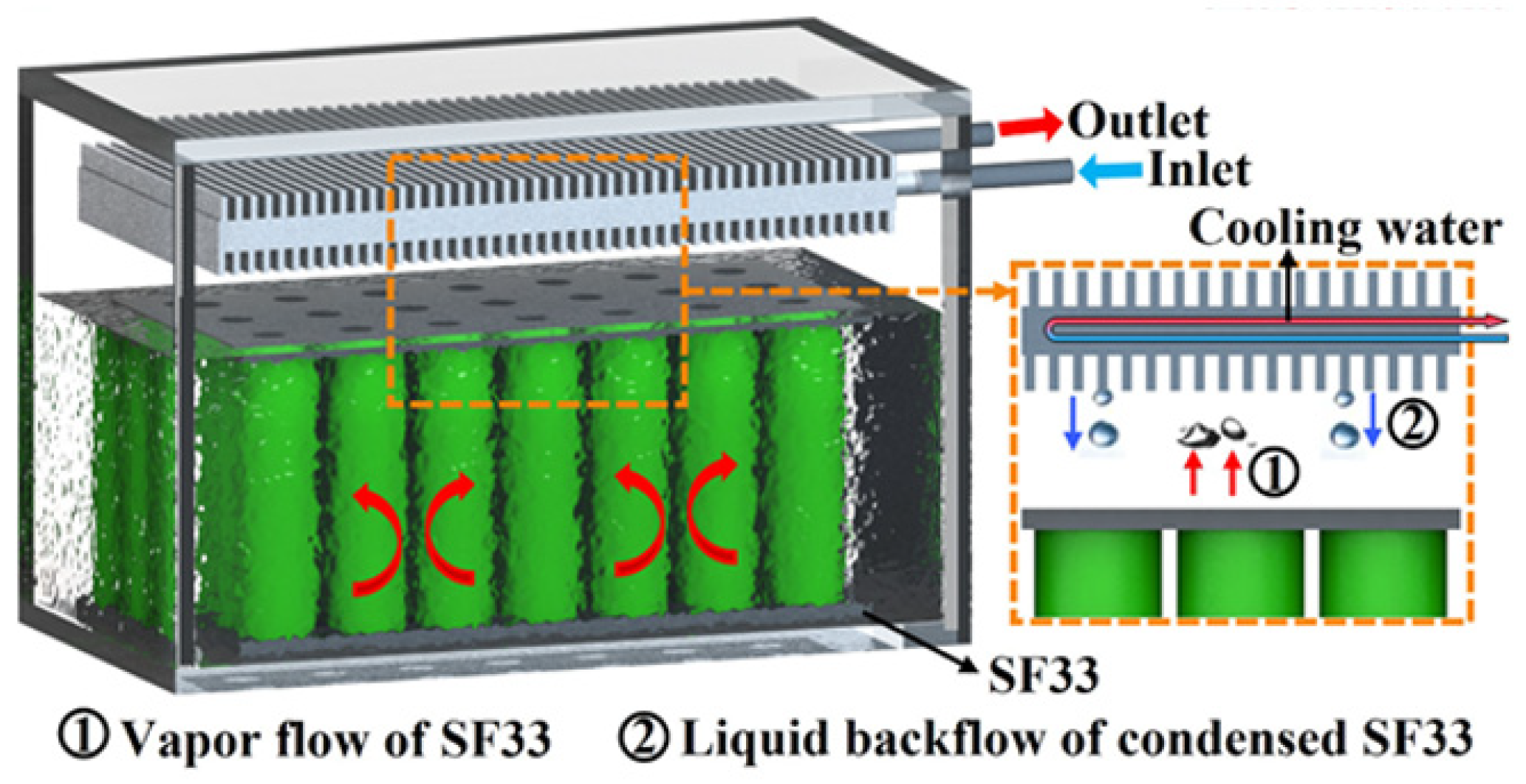
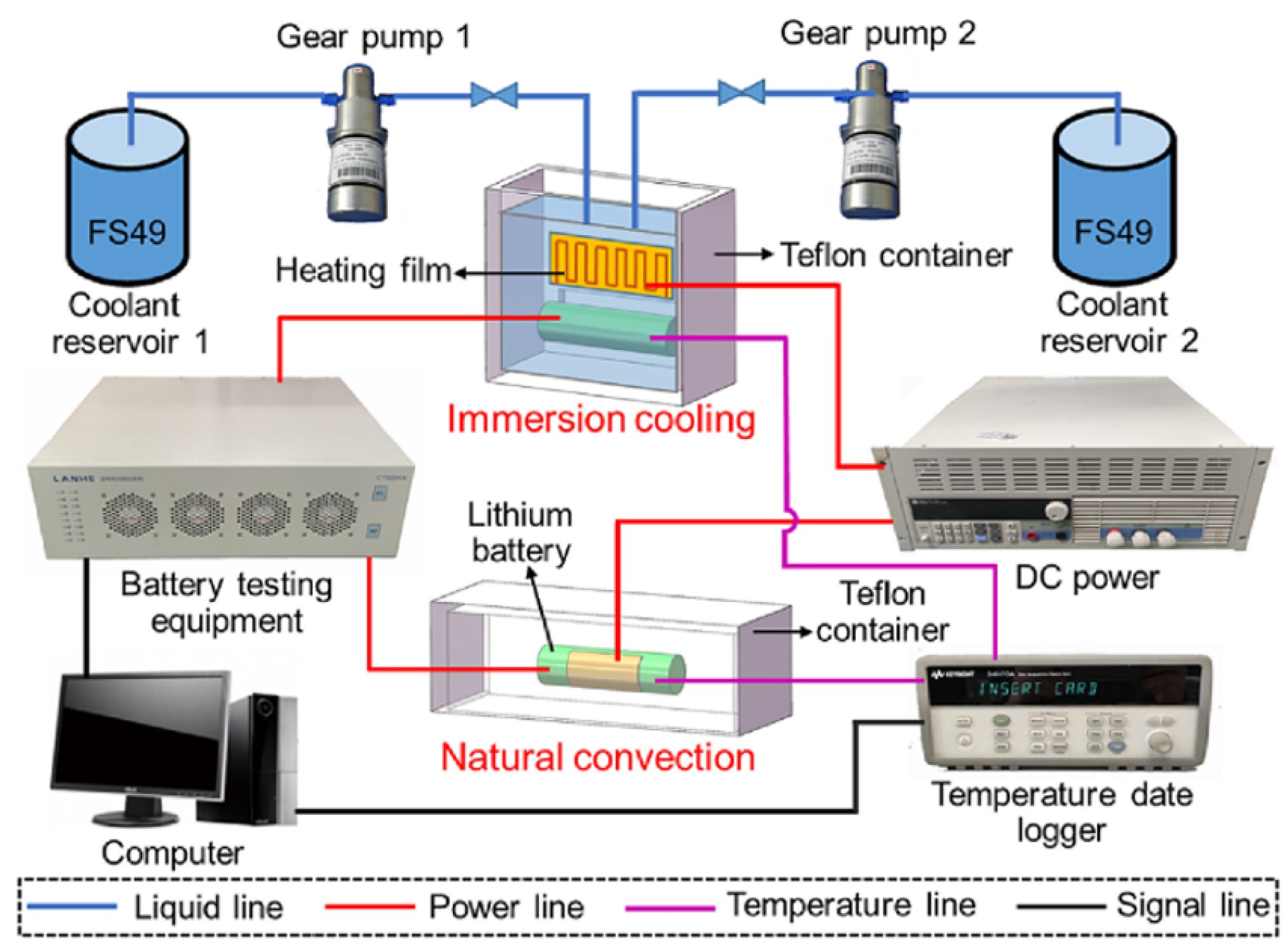
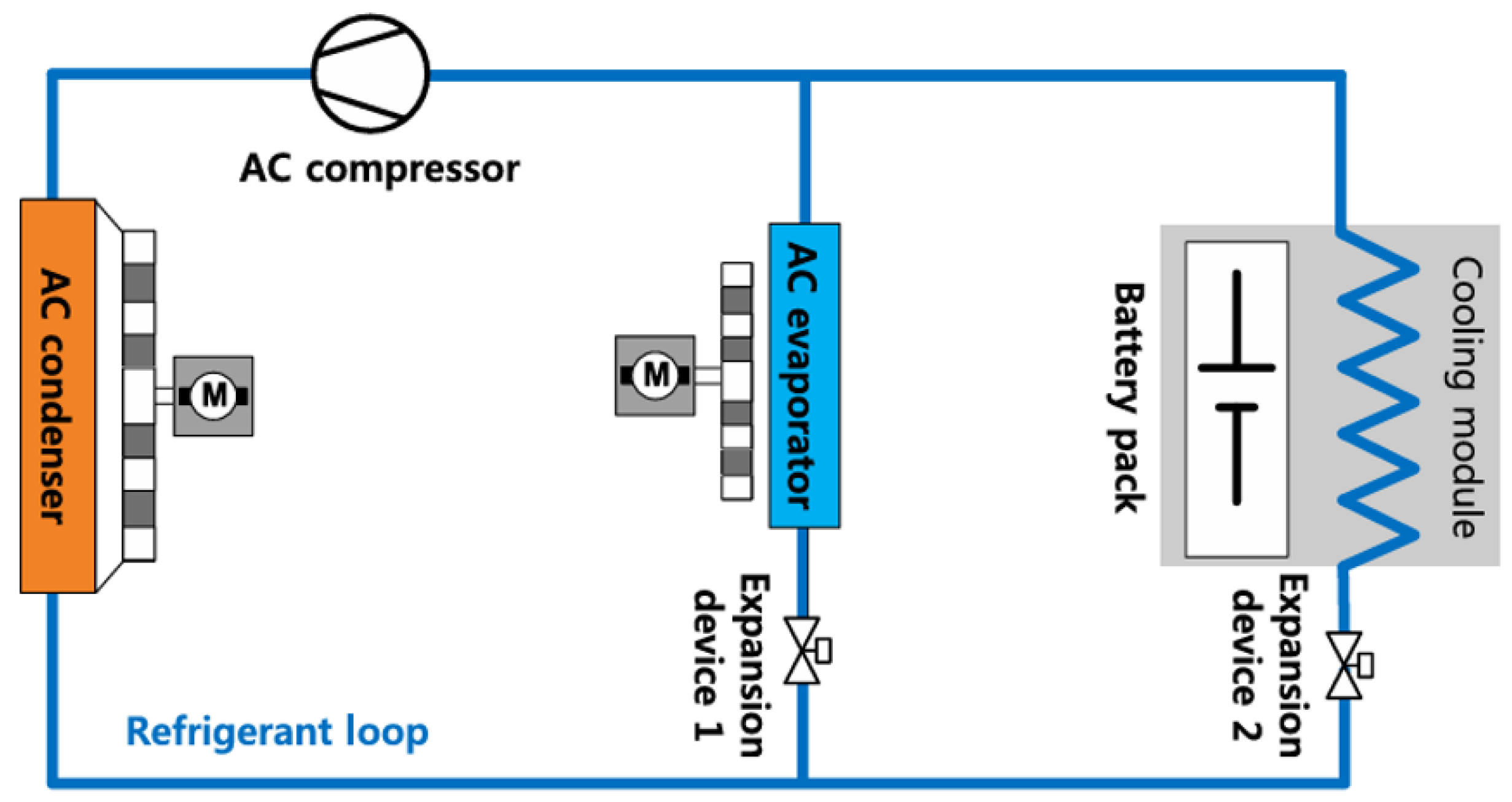



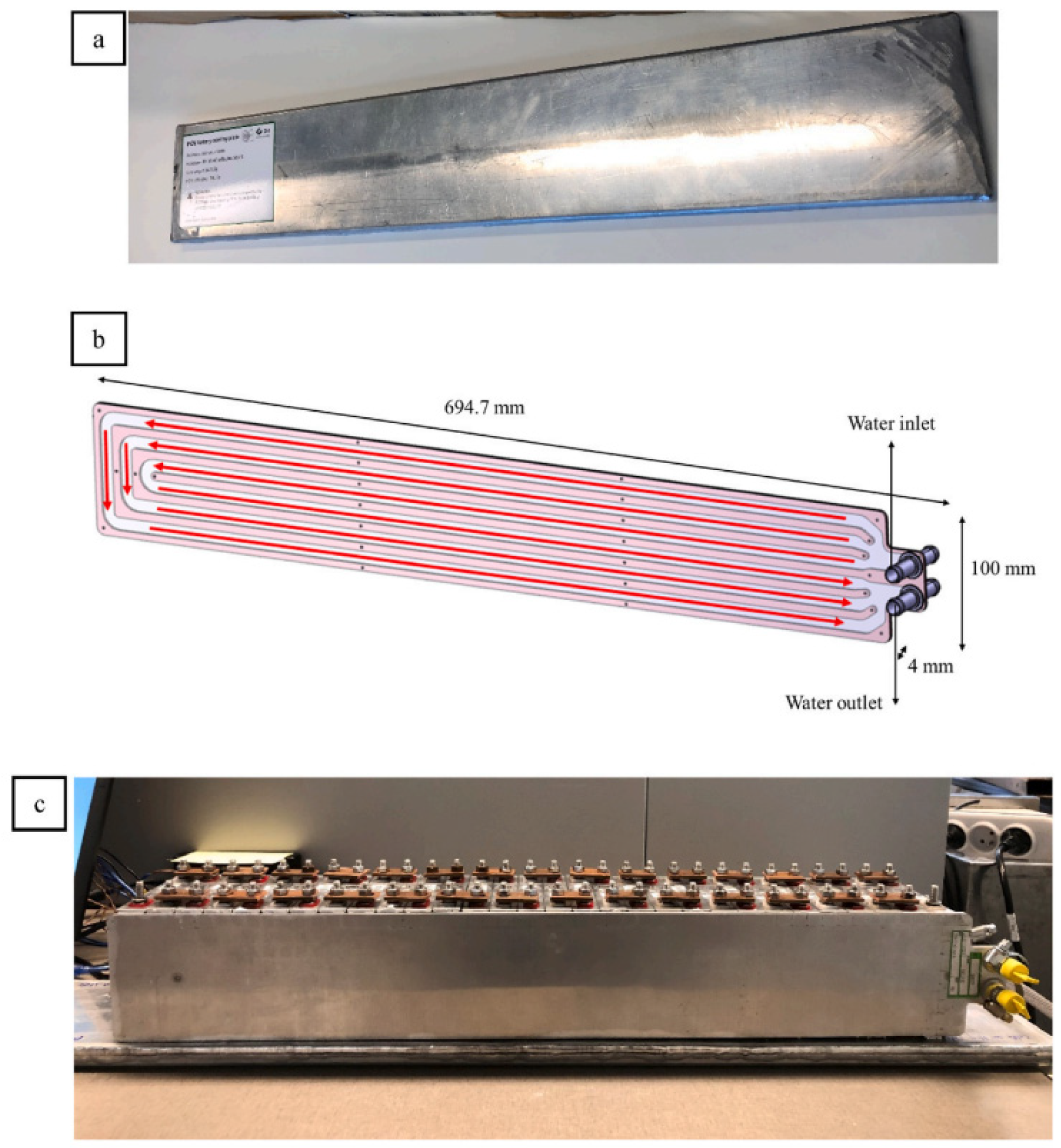
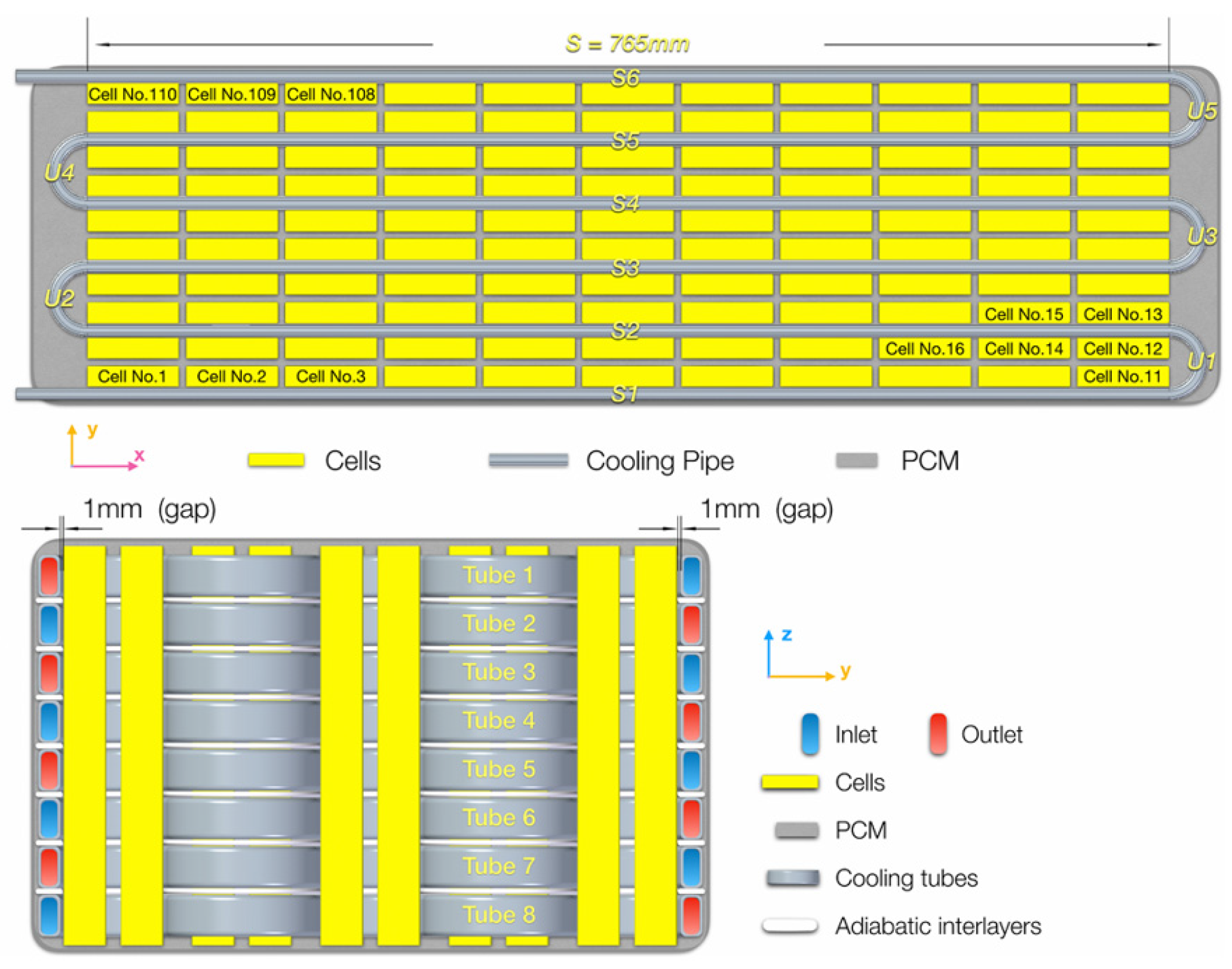
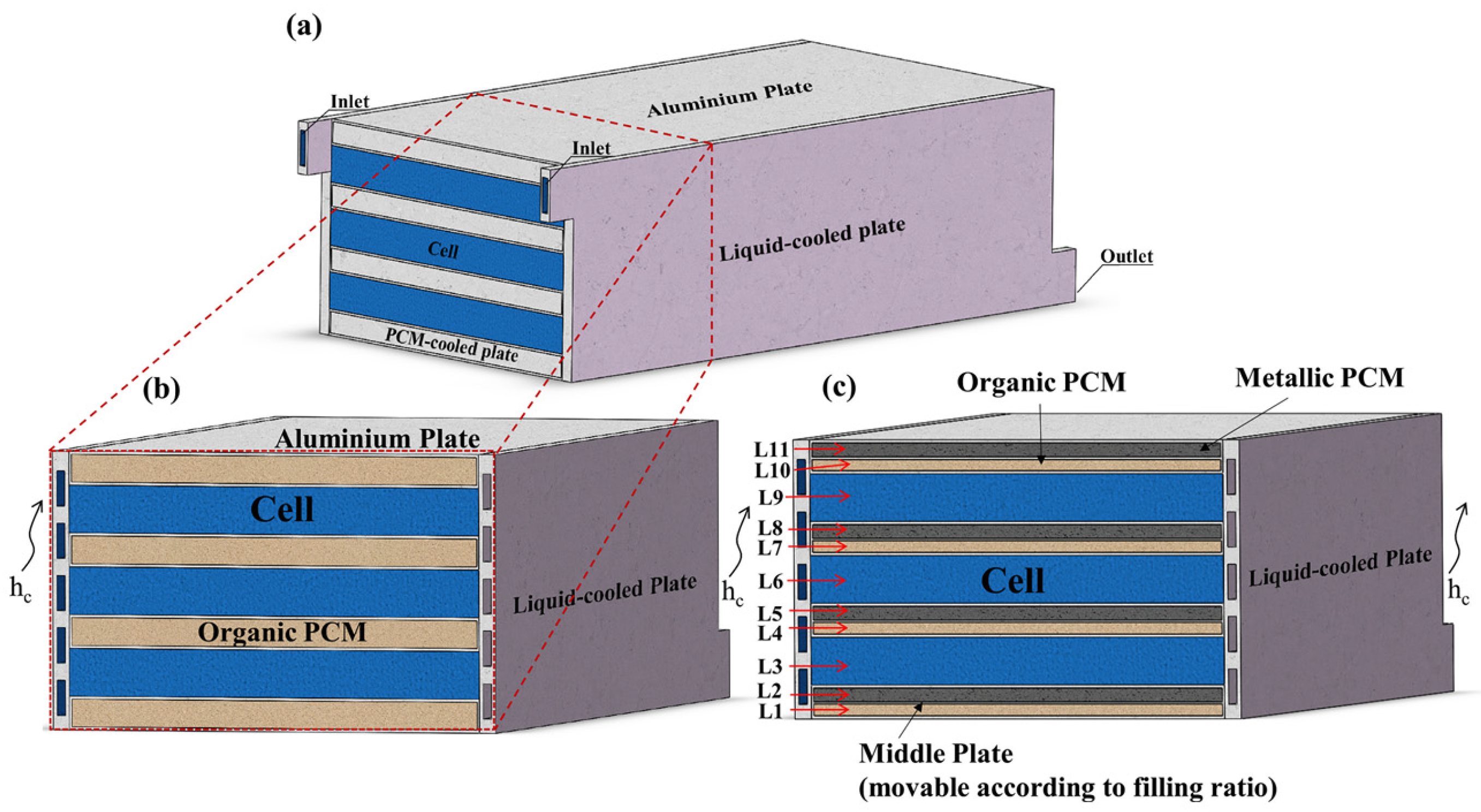
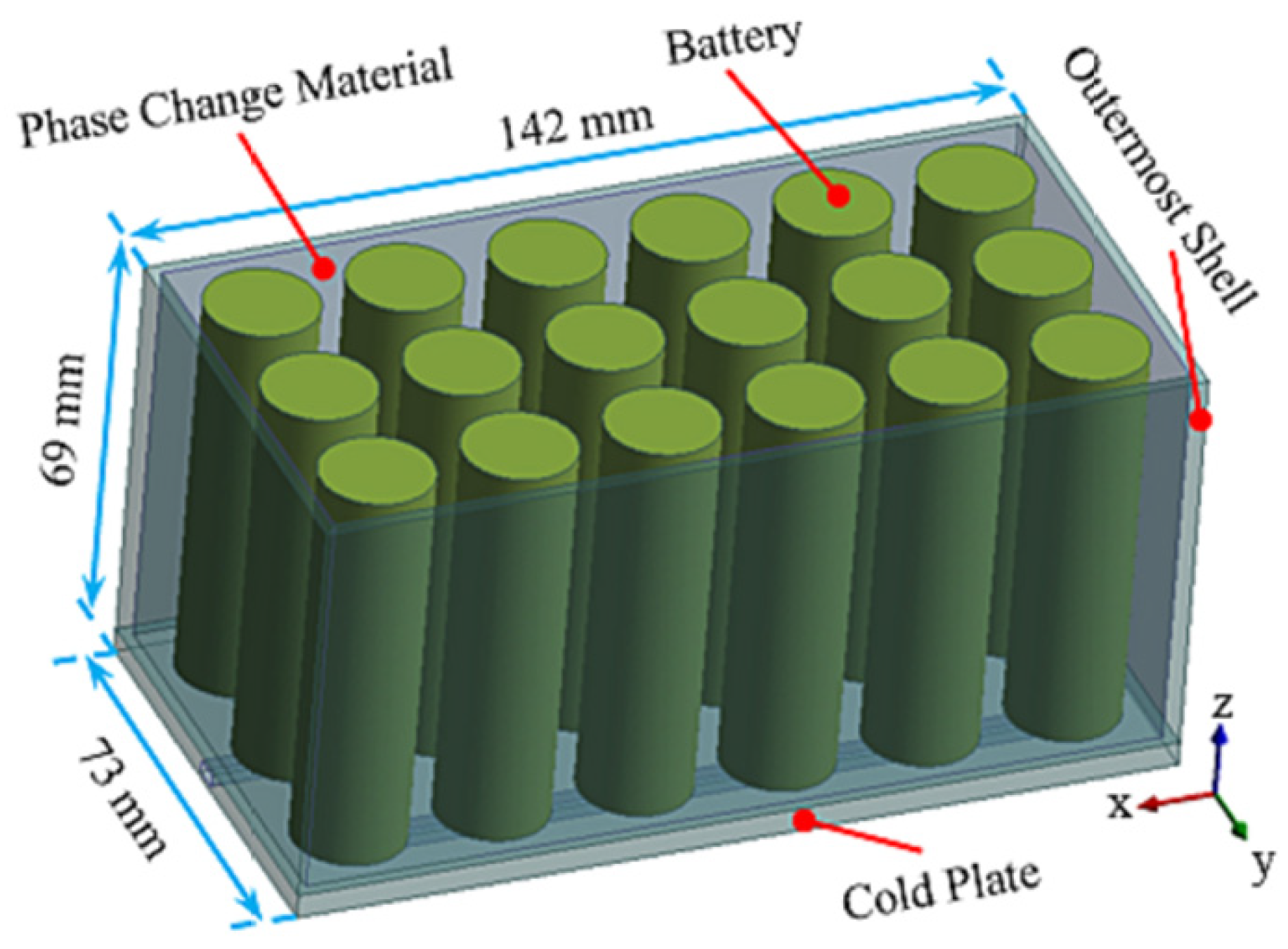

| Review | Focus of Review | Highlights |
|---|---|---|
| Keyser et al. (2017) [11] | Air cooling, liquid cooling, and refrigerant cooling for thermal management of batteries | Analysis of different cooling methods during extremely fast charging of batteries |
| Tomaszewska et al. (2019) [12] | Air, liquid, and phase change material cooling for thermal management of batteries | Summary of research on various cooling methods for battery fast charging |
| Thakur et al. (2023) [19] | Cold plate, phase change material, heat pipe, refrigerant, thermo-electric, and immersion cooling for thermal management of batteries | Summary of research works on hybrid cooling for fast charge/discharge cycles of batteries |
| Polat et al. (2023) [2] | Air cooling, phase change material cooling, and liquid cooling for thermal management of batteries | Compared and evaluated various cooling methods for DC fast charger systems of batteries |
| Khan et al. (2024) [20] | Liquid cooling, phase change material cooling, refrigerant cooling, and cooling-based machine learning for thermal management of batteries | Summary of different structures of cooling, and cooling-based machine learning for fast charge/discharge applications. The research on different cases of passive and hybrid PCM cooling for batteries |
Disclaimer/Publisher’s Note: The statements, opinions and data contained in all publications are solely those of the individual author(s) and contributor(s) and not of MDPI and/or the editor(s). MDPI and/or the editor(s) disclaim responsibility for any injury to people or property resulting from any ideas, methods, instructions or products referred to in the content. |
© 2024 by the authors. Licensee MDPI, Basel, Switzerland. This article is an open access article distributed under the terms and conditions of the Creative Commons Attribution (CC BY) license (https://creativecommons.org/licenses/by/4.0/).
Share and Cite
Tai, L.D.; Garud, K.S.; Hwang, S.-G.; Lee, M.-Y. A Review on Advanced Battery Thermal Management Systems for Fast Charging in Electric Vehicles. Batteries 2024, 10, 372. https://doi.org/10.3390/batteries10100372
Tai LD, Garud KS, Hwang S-G, Lee M-Y. A Review on Advanced Battery Thermal Management Systems for Fast Charging in Electric Vehicles. Batteries. 2024; 10(10):372. https://doi.org/10.3390/batteries10100372
Chicago/Turabian StyleTai, Le Duc, Kunal Sandip Garud, Seong-Guk Hwang, and Moo-Yeon Lee. 2024. "A Review on Advanced Battery Thermal Management Systems for Fast Charging in Electric Vehicles" Batteries 10, no. 10: 372. https://doi.org/10.3390/batteries10100372
APA StyleTai, L. D., Garud, K. S., Hwang, S.-G., & Lee, M.-Y. (2024). A Review on Advanced Battery Thermal Management Systems for Fast Charging in Electric Vehicles. Batteries, 10(10), 372. https://doi.org/10.3390/batteries10100372







